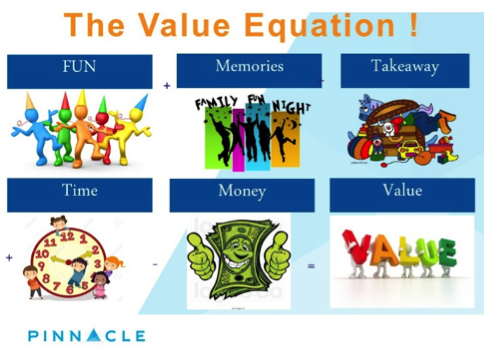Delivering Value in the FEC
The Little Things Mean a Lot
By George McAuliffe, Chief FEC Strategist, Redemption Plus

George McAuliffe
It was a beautiful day recently when our family decided to go to out to lunch. We headed for a local restaurant with good food, great service, and an outdoor patio so we could enjoy the weather while we ate.
Unfortunately, we weren’t the only ones with that plan: The place was packed and there was a 45-minute wait. We walked down the sidewalk about fifty feet to another restaurant with an outside seating area and were seated immediately.
Our waiter was very pleasant and we soon had the order in. I started to wonder why people were standing in line for one restaurant fifty feet away while there was no wait in this one. The menus and price points were very similar. When the drinks came my daughter-in-law, who had ordered a Diet Coke, took a sip and made a face. When I asked her about it, she said it was Diet Pepsi, which was soon confirmed when she asked the waiter. She ordered her burger medium rare, but it arrived well done and had to go back. The waiter brought me a salad which I didn’t order as I knew my gyro sandwich would have all the lettuce and tomato I would need. Our otherwise attentive waiter returned to ask my daughter in law if she’d like a refill on her Diet Coke (i.e. Pepsi).
There were six of us at the table and the rest of the food was good and the service fine. The patio was nice, the table and chairs comfortable. None of the issues I’ve mentioned were a particularly big deal. As I thought about it, I realized that I probably had my explanation for the difference in popularity of the two restaurants: the little things.
The Value Equation for restaurants is simple. Patrons are there for the food type, quality, price, service and the atmosphere. These elements add up to the “dining experience.” It was a pretty stark realization to see a line in one place and empty seats in a comparable restaurant steps away. It also showed how easy it is, with just a few misses, to alienate customers. In the business of family and bowling entertainment centers, we arguably have more moving parts to manage which makes it even easier to tip the Value Equation in the wrong direction.
Defining Value
The FEC world has it good these days. With most of the country in an economic upturn, our forms of family entertainment have become mainstream. That breeds growth, and growth equals competition. Competition is showing up in various formats: traditional FECs, bowling entertainment centers, restaurant entertainment centers, pizza restaurants with entertainment, trampoline parks, escape rooms. You get the idea. And that’s just direct competition. We compete for people’s time and attention, as well their dollars, and there are many indirect competitors out there, including what our customers can do in their own homes, or even walking down the street on their smart phones.
Are we getting the details right to make sure that our guests are having a great experience, one that they’ll tell their friends about and one that they will value in a way that will keep them coming back?
Webster’s definition of value has seven answers, including:
• the monetary worth of something;
• a fair return or equivalent in goods, services, or money for something exchanged;
• relative worth, utility, or importance;
• something (such as a principle or quality) intrinsically valuable or desirable;
• a numerical quantity that is assigned or is determined by calculation or measurement.
So “value” can mean many things. When we look at guest experience, here’s how we think the guests evaluate their FEC experience:
Lots of details go into ensuring the guest’s Value Equation is where we want it to be (see graphic above).
“Fun” goes to game and attraction selection, the attitude and efficiency of staff, and the playability of games and attractions, among other things.
“Memories” similarly factor into the equation and can be either good or bad. (Disney calls them “magic” or “tragic” moments in guest service.) Games and attractions that allow for social experiences go a long way to creating memories.
As far as “Takeaway” is concerned, redemption merchandise is the central opportunity here. This means great prizes at fair ticket values and markup so guests can leave with a tangible reward with a good perceived value.
“Time” is the final item on our plus side of the equation: too many facilities “get the money out of the customers’ pockets” too quickly. Great operators fully understand the time-entertainment component and craft their attraction mix and pricing to optimize time. You can also argue that “time” can appear on the minus side of the equation as the guest is investing his time in your FEC experience.)
All of the above are weighed against “Money.” Guests balance the fun they had, the memory or social value of the experience, the quality of the takeaway, and the amount of time they were entertained against the money they spent.
How do you measure up? As mentioned earlier, there are many parts to be managed for the longterm success of the FEC enterprise. My recent lunch experience just goes to show that managing even the smallest details mightily affects that success.
George McAuliffe has created and operated family entertainment centers from 2,000 to 150,000 square feet as a corporate executive, entrepreneur and consultant. He’s President of Pinnacle Entertainment Group and leads the company’s strategic advisory team. George, recently moved back “home” to the Jersey Shore with his wife Julie, has a passion for passing along what he’s learned in the fun business to the new generation of operators and suppliers.
Readers can visit grouppinnacle.com for more information or contact George at georgemc@group
pinnacle.com; phone: 314-422-7197.





